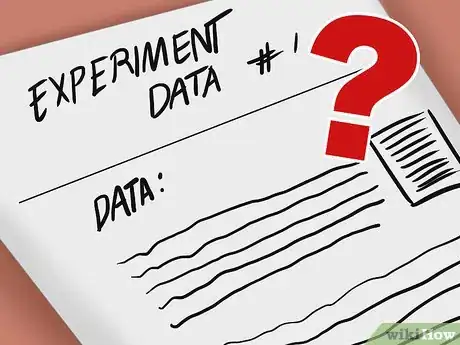This article was co-authored by wikiHow Staff. Our trained team of editors and researchers validate articles for accuracy and comprehensiveness. wikiHow's Content Management Team carefully monitors the work from our editorial staff to ensure that each article is backed by trusted research and meets our high quality standards.
This article has been viewed 39,540 times.
Learn more...
Deductive reasoning is also referred to as the “top down approach”, where you start with a general idea and work your way down to a specific idea or a specific solution. As professor Nyaboke Christopher Marwa puts it, deductive argument is from universal to particular. Often you learn how to use deductive reasoning in science class in high school to prove or disprove a hypothesis, but deductive reasoning can also be applied in other areas of your life.[1] You can apply deductive reasoning at home with a partner or sibling during an argument or discussion or at work when trying to come up with a business solution. Deductive reasoning can be a useful tool for analyzing a situation or issue and coming up with a specific solution or answer.
Steps
Applying Deductive Reasoning at Home
-
1Understand the deductive argument. When you use a deductive argument, you are trying to prove an argument is valid by showing that the argument’s assumptions are true. The premise of the argument needs to seem strong enough to support a specific conclusion. If the premise of the argument rings true, the argument can be proven as sound or logically correct.[2]
- For example, you may notice that it’s sunny outside when you wake up. You may then deduce that your husband left the house without an umbrella and not wearing a raincoat. You can then make a deductive argument that your husband will come home without an umbrella and in a sports coat, not a raincoat. Based on an analysis of the premise, you can form a deductive argument and make an assumption that has a high likelihood of being correct.
- A deductive argument focuses on making a guaranteed conclusion, where the truth of the conclusion is highly probable. The argument should contain a truth that is implied by the premise. You can conclude your husband is not carrying an umbrella when he gets home, for example, because the premise (sunny skies) implies the truth of your argument or conclusion.
-
2Use deductive reasoning to validate your partner’s assumption. There are numerous situations with your spouse or partner where you can use deductive reasoning to validate an assumption. This can vary from smaller assumptions to larger assumptions.[3]
- For example, your partner may complain that he is always late for work in the morning. He may then make the assumption that he will get to work on time if he leaves the house earlier in the morning. You may then point out that it takes your partner about thirty minutes to get to work every day, regardless of traffic. You can then make a deductive argument: if your partner leaves the house no later than 8:15 am, he can get to work by 8:45 am and not be late for his 9 am day.You have deduced that his thirty minute commute means he must leave by 8:15 am to arrive at work on time. In this way, you are using deductive reasoning to support his assumption.
- You may also be in a situation that may have more serious consequences if the deductive argument is not followed. For example, your partner may be allergic to nuts. You can then deduce that he should not eat ice cream that contains nuts, as this could lead to an allergic reaction and serious health issues. The premise, that your partner is allergic to nuts, proves your deductive argument, that your partner should not eat the ice cream that contains nuts.
Advertisement -
3Apply a deductive argument to a family member’s issue or problem. Deductive reasoning can also be useful for solving an issue or problem. Often, deductive reasoning comes into play when someone has lost an item or a problem needs to be solved.[4]
- For example, your sister may tell you she lost her phone charger. Rather than search aimlessly around the house for the charger, you can use deductive reasoning to make an argument for where the charger may be found.
- Start by gathering information from your sister in the form of a question and answer. You may ask her, “Who last used the charger?” “When was the last time you used the charger?” “Where do you usually plug in the charger in the house?”
- Based on her answers to your questions, you can use deductive reasoning to make an assumption about where the charger can be found. For example, she may answer, “Mom used it yesterday to charge her phone” or “I usually plug it into the bedroom outlet”. If she provides the first answer, you can deduce that your mother may know where the charger is located. If she provides the second answer, you can deduce that the charger is likely in the bedroom outlet.
- In both instances, you can use deductive reasoning to reach a conclusion that could be valid and true. It can then lead to recovery of a lost item or the solution to an issue or problem.
Applying Deductive Reasoning at School
-
1Understand deductive reasoning in relation to science and mathematics. Deductive reasoning is often used to make inferences in science and math, as you must use formal logic to support a conclusion or a solution. You can use deductive reasoning in a science class or a math class to test an existing theory or hypothesis. In science, you can then support your conclusions with experimental data. In math, you can support your proof with supporting proofs or equations.[5]
- Deductive reasoning is often represented as the general (X) and the specific (Y). There are three steps to forming a deductive argument.
- First: You will note that every X (general) has the characteristic Y (specific). Second: You will note that the thing you are trying to prove is X (the general). Third: You can deduce the thing you are trying to prove has the characteristic Y (the specific).
- For example, you may start with the general idea: Every rose has thorns. You may then note: The thing in my hand is a rose. You can then make a deductive argument: Therefore, this thing I am holding can probably prick me.
- From this deductive argument, you can do further experiments to find cases where your argument may not be true. For example, you may try to find roses that do not contain thorns or that can be manipulated to not grow thorns. You may also investigate why roses have thorns and what purpose thorns serve on roses.
-
2Apply deductive reasoning to a scientific problem. You can use deductive reasoning as part of your scientific method in science class. Forming a deductive argument is an important step in a scientific study, as it allows you to make assumptions about your hypothesis and then test those assumptions through experiments. You can then use the data from the experiments to confirm or dispute your hypothesis.[6]
- Start by observing a phenomenon that forms a problem or question. For example, you may observe in your chemistry class that noble gases are stable.
- You may then make a hypothesis by using deductive reasoning. Noble gases are stable. Neon is a noble gas. Therefore, you can deduce that neon is stable.
- You can then design an experiment that supports or refutes your hypothesis. This may be an experiment where you test and observe neon’s reaction to certain environments, particularly environments where it is clear when a gas is stable or unstable.
- You will then collect the data from the experiment and analyze the data. The data should be given a rigorous analysis to ensure your conclusion is well supported.
- Finally, you will make a conclusion using the data. You will need to determine if the experiment refutes or supports your hypothesis, or your deductive argument. If it confirms your hypothesis, you can confirm your deductive argument: Noble gases are stable. Neon is a noble gas. Therefore, neon is stable.
-
3Solve a math problem with a deductive argument. In mathematics, deductive reasoning can be used to formulate the answer to a mathematical problem. The more complex the mathematical problem is, the more complex your deductive argument (or proof) will need to be.[7]
- In the most basic form, a deductive argument in mathematics could be represented by: If A=B and B=C, then A=C. This means that you make a general argument: A=B. You then note a more specific argument: B=C. You can then deduce the following argument or proof: A=C.
Applying Deductive Reasoning in the Workplace
-
1Use deductive reasoning to solve a company problem. You can apply deductive reasoning in your workplace by using it to solve a company wide issue or problem. This logical approach can lead to smarter business practices and higher cost savings, as there will be less guessing and uncertainty around the problem or issue.[8]
- For example, your company may have difficulty determining how many flats of printer paper to order every month for the office. You may decide to apply deductive reasoning to this issue.
- First, you will start by asking several general questions: How often is the printer used each month? How many flats of printer paper did the office use every month for the past four months? Is the amount used consistent every month?
- Second, you can use the answers to your general questions to form a deductive argument. If the printer is used every day, fifty times a day, on a constant basis each month, and if the office used an average of 50 flats of paper a month, you can then deduce that there should be an order of 50 flats of paper per month for the office. You have used information to form a premise (50 flats used on average a month) and then formed a deductive argument based on the premise.
- You can then place the order and note if the paper lasts for the full month. If so, you can continue to order 50 flats of paper every month. If the paper runs out before the end of the month, you may need to adjust your premise and your deductive argument. However, the logic of your argument is based on a high probability of truth in the premise and will likely be proven true.
-
2Address a client issue with deductive reasoning. You can apply deductive reasoning in a situation with a client that goes sideways, especially if the client is very logic focused. Deductive reasoning is useful for businesses who are trying to come up with practical solutions to problems or issues. However, it is important that you gather enough supporting information from your client to ensure the solution or deductive argument is based on a solid premise.[9]
- For example, your client may have an issue with the way you are communicating with her. She may complain that she does not feel she is kept up to date on the status of the project you are both working on.
- You can then ask your client several general questions: How can you provide more up to date information? In what ways can you make the client feel more connected? What information would she like to be made aware of in relation to the project?
- Your client may note that she would like status reports every week. Based on the client’s answers, you can form a premise: weekly status reports will keep your client happy. You can then deduce that weekly status reports will ensure your client is up to date on the status of the project.
- You can apply this deductive argument by providing your client with weekly status reports. The deductive argument has a high probability of being effective, as it is based on a logical and supported premise.
-
3Settle a dispute between employees with a deductive argument. You can also apply deductive reasoning to a dispute or argument between employees. To do this, you will need to isolate the premise of the dispute and form a deductive argument based on the premise.
- For example, you may have one co-worker who claims that his cubicle mate is always forgetting to turn off his computer before he leaves for the day. The cubicle mate may then argue that the co-worker forgets to turn off his computer as well. This could lead to a heated dispute between both employees.
- As the mediator, you will need to form a premise that could solve the dispute or the issue. You should ask the employees several questions, including: What tactics could you both use to remember to turn off your computers? How can you both support each other and make sure the computers are always turned off? What tactics are used by other employees to ensure their computers are always turned off?
- You can then use the employees’ answers to form a premise. For example, the employees may agree that whoever is the last person in the cubicle will turn off both computers. The premise may then be: the last person in the cubicle is responsible for turning the computers off. You can then deduce that based on this premise, the computers will always be turned off.
- Apply this deductive argument as a solution to the dispute between the employees and observe if the argument helps to reduce the dispute. Though it can be difficult to predict human behavior in terms of logic, you can safely assume the solution will work to resolve the dispute, as it is based on a strong premise.
References
- ↑ http://www.bio.miami.edu/dana/dox/scientific_method.html
- ↑ http://www.iep.utm.edu/ded-ind/
- ↑ https://explorable.com/deductive-reasoning
- ↑ http://basicinstructions.net/basic-instructions/2011/5/1/how-to-use-deductive-reasoning.html
- ↑ http://www.bio.miami.edu/dana/dox/scientific_method.html
- ↑ https://www.csun.edu/~vceed002/ref/reasoning/deductive_reasoning/index.html
- ↑ https://explorable.com/deductive-reasoning
- ↑ http://www.iep.utm.edu/ded-ind/
- ↑ https://www.linkedin.com/pulse/deductive-inductive-abductive-reasoning-business-didier-koffi-m-s-/




































































